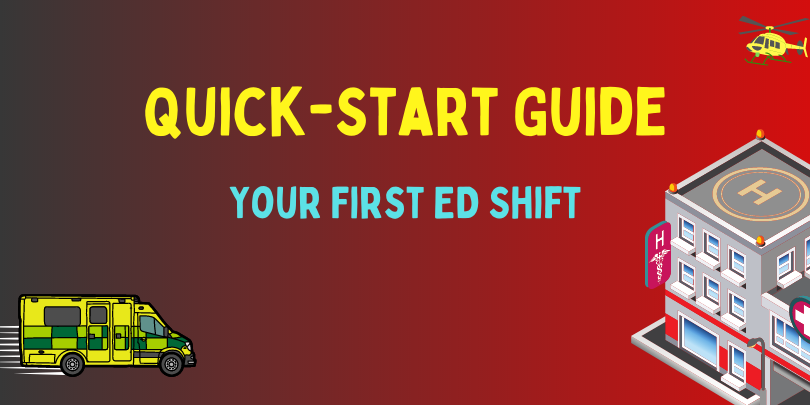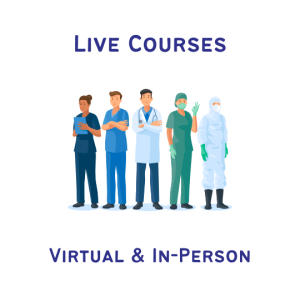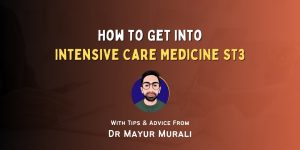
Published May 15, 2023 | Updated August 17, 2023
By Callum Airlie
Trained in Edinburgh with a specialist interest in Emergency Medicine and a wilderness twist. Not afraid to take an unconventional route through specialist training!
Starting a job in the Emergency Department (E.D.) soon and worried about what this infamous department might be like? Then this is the guide for you! Screenshot it, bookmark it or read it once and hope that some of it sticks – these top tips will make your first few days a lot less stressful and hopefully a little fun!
Here we cover a few things to keep in mind going into your first few shifts or indeed something to fall back on when times get tough, and you need some help.
The second half of the article will briefly explain how the Emergency Departments in the UK work. This may be useful if you’re new to the UK system or if you’ve just been in an E.D. that often!
11 Top Tips for Your First ED Shift
The E.D. has a reputation for being full-on, stressful and chaotic, but honestly, that’s just the stereotype when seen from the outside. All Emergency Departments have a clear support system, a structure to manage lots of people and typically hold the friendliest health professionals you’ll meet in the hospital!
Here we cover a few things to keep in mind going into your first few shifts or indeed something to fall back on when times get tough, and you need some help.
1. Breathe and Remember Your Training
It’s the same medicine, just in a different location. The reputation for being stressful and scary may seem intimidating but there are still just sick people requiring help.
Don’t get overwhelmed by the time targets and rush things, do good work and be thorough. Better to be in E.D. For 4.5 hours and have a good experience than to be rushed through to the wards in 3.5 hours with a drug error on your chart.
2. Nurses Are Your Best Friends
E.D. Nurses are the BEST.
They are excellent at procedures, have endless patience, and posess intuition second to none. They will inevitably be your guides for the first few shifts.
Don’t forget the other allied health professionals; porters, health care assistants, and physios are all a wealth of knowledge and have all been in the department a lot longer than you have!
Remember everyone’s names! Your colleagues will be helping you a lot every day in the E.D., and it makes a real difference to both of your experiences.
Tip for Remembering Your Colleagues’ Names
Do you struggle in remembering names, and want to make sure you don’t offend your new nursing best friends by not having the foggiest what they’re called? Try this
Next time you’re in the ED, use somebody’s name three times in the same shift whilst talking to them – it tends to stick!
If you forget it initially, ask in the same shift and avoid having to ask again three weeks down the line!
3. Locate the Equipment
When you start out in a new department, don’t limit your search to just finding the bloods trolley; Find the stockroom with the extra cannulas, blood bottles, and procedure equipment. This will save you so much time!
Here’s a list of ED equipment you should know where to find:
The HCAs and porters know this place!! Ask them where everything is located, and go with them to find things. Learn how to fish, don’t just ask for a fish!
In emergencies, you may need to be the runner, so it’s good to know where to run to! Ask a senior to help familiarise you with resus room equipment when they have 5 minutes. Better to find the suction now than when you really need it.
4. Fuel Your Body!
Rest well, eat well and take your breaks!
E.D. is a busy place with long shifts, it exhausts your mind and your body, especially when everything is new. With ever-changing shift patterns, as well as plenty of weekend and night shifts, you need to know how to keep your body working for you.
You’re no good to anyone if your own blood sugar is 3.5 and you stayed up till 3 am the night before!

5. Don’t Be Afraid to Ask for Help
When you first start in the ED, run every patient past a senior! Even if you think it’s a straightforward case. Remember, you don’t know what you don’t know!
It doesn’t have to be an emergency to ask for a second opinion on a rash or the size of someone’s tonsils.
There truly is no such thing as a stupid question. Ask to be observed, ask for advice, ask to watch a new procedure. Ask, ask, ask!
6. Find Out the Patient’s Home Situation
Always keep in mind – is your patient managing?
This is especially true for elderly and vulnerable patients, but not exclusively. Small medical problems might be the tipping point in a usually stable home situation. The reason for admission isn’t always because medically it was essential to pump somebody full of IV antibiotics.
Similarly, you’re not often going to send 95-year-old ‘John’ home alone at 23:00 when he’s taken a fall earlier that day whether he’s medically well or not! You may need to speak to the family and see if somebody can accompany the patient home to make sure they’re ok.
Home Situation – Questions
When you’re bouncing from patient to patient and trying to hit those time targets, it can be easy to ditch the social history. This might work for the 45-year-old fit and well man with an elbow injury, but beware when it comes to the frail or comorbid population!
The hospital is a dangerous place for the frail. They can pick up infections, struggle with worsening mobility, or become distressed at the change of environment. When thinking about a discharge from ED, you need to weigh up the risks of discharge vs “social” admission.
Here are some questions to consider when taking a social history in the ED:
If any answers to these questions concern you, consider whether you are able to make a safe discharge.
7. Work Your Way Back from “Worst Case Scenario”
The E.D. requires a slight change of thinking compared to the wards. You’re not always going to develop a clear diagnosis.
In your differential list rule out the most life-threatening potential causes first! In the ED you need to think about the ‘worst case scenario’ and work your way back from that.
Don’t go hunting for one specific diagnosis; Think about what ‘category’ someone falls into, rather than trying to be a house-style medical detective. For example, ‘acutely unwell’ or ‘stable’. ‘Surgical’ or ‘medical’.
Treat what’s treatable as best you can (e.g. pain, dehydration, fever) and gather information to (hopefully) rule out life-threatening pathology.
8. Communication is Key
You need to keep tips 6 and 7 in mind when thinking about when to escalate. Flag to the nurse in charge or consultant early if you think a patient may require admission. Whilst this is not life or death your colleagues all over the hospital will thank you!
Admissions take time, beds need to be found, people need to be shuffled and the earlier this starts the easier life is for everyone
It’s easier to suddenly find you can safely discharge someone than it is to conjure a bed out of thin air for an admission.
9. Remember Your Safety Net
This might be the first time you’re discharging patients home without a senior having physically reviewed the patient first. This can be very scary and may keep you awake at night for the first few shifts! Remember to run every patient past a senior before discharging, at least while you’re settling into the ED!
When discharging a patient, it’s not just about if they are medically fit. Do they understand what’s happened? Do they have all the information they need?
Information booklets and online resources are great tools to use to make sure your patients are well-informed! Give both verbal and written information to your patients. The E.D. is a very overstimulating environment, so half of the wonderful information you gave your patient will be impossible for them to remember once they’ve passed the front door. Having a good leaflet or a piece of paper with an internet resource is invaluable to them.
Safety netting is key. Remember to tell all your patients what to do and how to seek help if their symptoms persist, worsen or they remain worried! Ensure they know that they CAN return to the ED! Sometimes illnesses develop over time or new information comes to light – this isn’t a single-use service!
Safety Netting Tools
10. Leave Prejudice at the Door
If you’ve got this far through training you likely already have an open mind, however, this could not be more true in the emergency department.
You will see people from all walks of life, some of whom will have had very tricky home circumstances and personal challenges. All we see is a snapshot when people need help, it’s important to remember you don’t know what anyone has been through leading up to that snapshot.
11. Don’t Forget to Smile!
The vast majority of patients coming through the emergency department are at their lowest. They’re in pain, they’ve been waiting hours, and they’ve been struggling with their symptoms for days already.
You’re one of the first people that patient sees; A smile and a kind word goes a really long way to easing the pain of their experience.
Good rapport makes for better care and better experiences!
That’s it! Follow these simple tips and your first few shifts will be a lot less scary and distinctly less stressful. They’re also really useful to keep in your back pocket and to remind yourself of when things get tough!
Look after yourself, rule out the life-threatening emergencies, and safety net and you’ll sleep easy at night knowing you’ve done a good job.
How the Emergency Department (A&E) Works in the UK
If you’ve grown up in the UK and were as accident-prone as I was, then this next section may not be as useful as the first half!
However, if you’re moving to the UK to start work as an IMG, trained in a different country, or were lucky enough not to need an E.D. trip before, here’s a rough guide to how the departments work.
Disclaimer: all E.D.‘s are run slightly differently around this central framework and you may find your experience to be different. This guide is to help prepare you and give you an idea of what to expect and is not intended to be an exhaustive manual to follow. Ensure that when you start work you check in with your supervisors and ask all these questions to double-check your understanding of the system.
Walk-in Patients
Let’s start with ‘the walk-ins’ and follow the patient track to help you understand their journey.
First of all, never presume that if a patient walked in then they’re not as sick as those who called an ambulance. All sorts of septic and trauma patients make their own way to the E.D., whether it’s through stubborn grit or because their symptoms are still developing. These patients can often be the sickest in the department.
First things first, walk-in patients check in at reception. They’ll give basic details such as name, date of birth, address etc. which allows their hospital identification number to be found and their information pulled up on the system. If they’re from the area, this may allow you to see previous medical history in their notes. If new to the area, you might not have access to any of their history.
Once they’re checked in and on the system, they’ll be seen by a triage nurse in a designated side room. This is their first true assessment, where observations such as heart rate, blood pressure, temperature etc. are taken. The triage nurse will ask them for a brief history, and if appropriate can insert a cannula and take blood tests.
If there is an urgent indication, the nurse may request an immediate ECG at this point, depending on the hospital this may be performed by somebody else shortly afterwards. These ECGs will need to be checked and signed by a clinician to ensure there are no ECG signs that suggest a need for immediate intervention.
UK emergency departments then use the Manchester Emergency Triage Tool and allocate patients a category based on their urgency to be seen. 1 (red) being the most urgent and 5 (blue) being the least urgent.

Ambulance Arrivals
Now let’s discuss the ambulance arrivals. On average these patients tend to be more unwell than the ‘walk-ins’ however it’s certainly not uncommon for somebody to come in by ambulance and still (appropriately) take a seat in the waiting room!
These patients have already had an initial assessment by the paramedics and often had management initiated. The interventions that have already been started varies, and can include any and all (and if you’re unlucky, none!) of the following:
If a patient is extremely unwell, paramedics may have already initiated CPR, inserted lines, or started airway manoeuvres (up to and including intubation & sedation).
Paramedics also provide initial triage and give a patient a category themselves. When patients are very unwell (category-1’s and more unwell cat-2’s) paramedics can call ahead to the department for a stand-by call or to make the team aware. A stand-by call requests a team of doctors and nurses to be ready and waiting for their arrival to continue urgent management – this is usually reserved for category 1 patients. If available they can give patient details over the radio to allow a streamlined check-in for the unwell patient and to allow past medical history to be obtained from the system.
Upon arrival to the E.D., ambulance patients still require a formal triage to be completed by a triage nurse. Depending on the size of the hospital this may be the same triage nurse assessing the walk-ins, or they may be somebody designated to ambulances only. Often this is a formality for the stand-by cat-1’s, however, situations can change en-route to the hospital with treatment the status of the patient can improve.
Bed-space Allocation
The next step is bed and room allocation. This is usually where things get a little more complicated!
There is usually a nurse in charge who is the primary manager of the available space. They work closely with the ED consultant in charge to maintain patient flow through beds appropriately. Typically category 1’s are moved straight into a resus room for close monitoring and immediate intervention. Cat-2’s have next priority on beds for urgent management and so forth. Once we reach cat-3’s and beyond we start to prioritise individuals who have been waiting the longest for space to be seen, assessed and treated.
Every E.D. manages their patient list differently, some use trays of paper notes in a prioritised pile, and others use a large computer screen to show current space and patients to be seen. Make sure to ask how your E.D. manages this before you start picking up patient notes and moving them around!
The E.D. is a large team and everyone helps out where they’re able. Once you’ve identified the next patient to be seen the most important thing is to let other people know they’re being seen. Typically this is on a computer system that places your name next to the patient’s name. This is incredibly important and helps prevent the wasted time of two doctors trying to treat the same patient!
Manage patients as you would normally, but communicate with the team twice as much as you usually would! Typically, nurses are assigned to a few numbered beds for the day – keep the nurse looking after your patient up to date with the current plan as best you can. They’re going to be helping you out by giving antibiotics, fluids, pain killers etc but they can’t do that if they don’t know what your plan is.
Radiology
Most commonly, simple X-rays can be organised from the E.D. without discussion – just make sure you check the local system on how to do this as they’re all different.
CT scans will typically need to be discussed with a radiologist or at least an E.D. consultant before approval. This is to help prioritise the queue and allow for prompt reporting of scans. Again, communication is key in such a busy department! If you’re following protocol, ordering CT heads (head injury/strokes) and other common scans might be performed without directly discussing with a radiologist, but more unusual CTs (such as angiograms, triple-phase etc) or MRI scans will probably require a conversation with the duty radiologist.
Out-of-hours availability for scans varies from hospital to hospital and the process for this also varies significantly. Any information I write here will likely add confusion and ambiguity if it’s different from your hospital, so it’s best to ask how it works when you get there!

Admission
If your patient requires admission I would recommend discussing this with your consultant for your first few shifts. Sometimes there are great support systems set up to try and manage patients safely at home, avoiding admission, and you may not know about these local programmes yet!
In many large hospitals, emergency departments can admit directly to medicine without discussion. This is designed to streamline the process for the patient and for the medical team given the high numbers of admissions. Surgical admission almost always requires discussion and review by the on-call surgical team prior to acceptance of the referral.
After discussing with your consultant, make sure to let the nurse looking after your patient know about the admission, and then speak to the nurse in charge. The nurse in charge will need to request a bed for the patient and this can take time when the hospital is busy! The earlier this process is started, the better, so do this as soon as it’s clear the patient requires admission.
The patient will be ‘clerked in’ by the admitting team where they will prescribe all of their usual medications, adjust anything as necessary and add anything new that is required. If your patient is particularly unwell and requires close observation, review of imaging, or repeated assessment at specific times, then please remember to call the doctors in the appropriate admissions unit to flag this. They may have a queue of 10+ patients to review and continue management for, so your patient may not be reviewed again for many hours unless you ask for this to happen specifically.
Please don’t forget to ask about important medications your patient may take that are not directly linked to their presentation. Things like insulin doses and Parkinson’s medication should never be missed or taken late, but can be easy to miss in the E.D. or in the wait for a review in the admission unit! Similarly, prescribing some ongoing IV fluids and as-required (PRN) painkillers will be immensely helpful for the patient and the next team; given the likely multi-hour wait until they are fully clerked in.
Time-Critical Medicines
While it’s not your responsibility as the ED doctor to prescribe all of an admitted patient’s medications, you must ensure that any medications that are critically important or time-sensitive are not missed.
These include (but are not limited to):
Some of these medications should be increased, decreased, or omitted in certain acute conditions, so review them before prescribing.
Discharge
Your patient’s been treated, doesn’t require medicine, and is ready for discharge home? Fantastic!
This process will vary a bit but there are a few key areas that need to be reviewed. Their notes will need to be completed with details of your assessment, management given and further advice/follow-up provided.
Typically, these days, this is all electronic and therefore doubles as an informative discharge letter which is viewable in their notes for the future. This discharge letter is also copied to their GP to ensure they’re aware of the presentation. It’s best to write your notes concurrently as you progress with the patient management so that you can finish it off simply at the end, rather than relying on your memory after the patient has left the building.
Once the patient has all their information, any medication/prescriptions they need, and has a safe way home, speak to the nurse in charge and the nurse looking after the patient once again. They can then organise the bed space to be cleaned and prepared for the next patient, but can also start the process of discharging the patient on the electronic system. There is usually a separate list on the electronic system, where they can be moved to allow you to complete your notes before discharging them fully.
It is usually your responsibility to fully discharge the patient from the electronic system once all notes are updated, forms submitted and the patient has left the building.
Timings
I have deliberately not mentioned timings or targets so far. The famous ‘4-hour target’ specifies that within four hours of arrival at A&E, a patient should be seen, treated and discharged or referred. For your first few shifts, however, this should not be your priority. Focus instead on providing quality patient care and effective communication. Speed and efficiency will come with experience! Don’t rush – this is how mistakes happen!
The primary timings you should keep in mind initially are clinical timings such as antibiotics in sepsis, thrombolysis window for stroke, and Primary PCI for myocardial infarction. Additionally, category-1 patients should be treated immediately, cat-2’s should receive a doctor’s assessment within 10 minutes, and cat-3’s a doctor’s assessment within 1 hour. Knowledge of these timings will allow you to work safely and appropriately. As you gain experience you’ll start ‘beating’ the four-hour target.
I sincerely hope this guide has been useful and allows you to start work with peace of mind and a degree of insight! The E.D. really is a wonderful place to work and you’ll learn so much so quickly. Best of luck and remember to have fun and smile!













